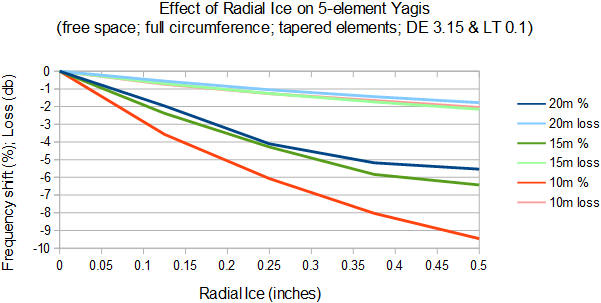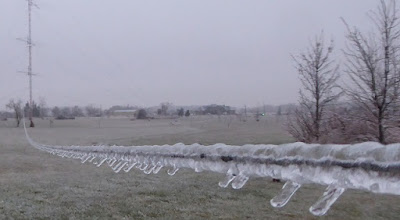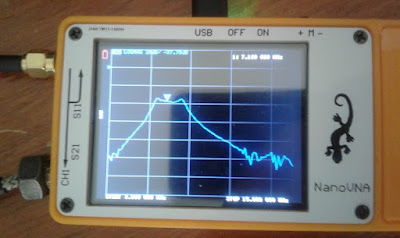On the second day of the recent CQ WPX SSB contest we had an ice storm (freezing rain). All my antennas survived the moderate amount (up to 5 mm) of ice. The impact of the storm was far worse to the west of us, with many lost trees and antennas. The high SWR of most of my antennas made operating the contest a hassle. I don't really like WPX so it was no great loss.
This is not the first time I've dealt with ice; it's a common weather event in this region. I know from experience how ice has mechanical and electrical effects on wires and aluminum elements, and towers. The major worry is antennas and towers breaking and even falling to the ground. That is a serious hazard. The electrical effects are not often given the same attention. These may only come to the fore during important operating events like contests.
The electrical effects are unsurprising. Ice is a dielectric so it behaves as a lossy insulator. That lowers the VF (velocity factor) and therefore increases the electrical length. The same is true for antenna made from insulated wire. But the effect of wire insulation is fixed and therefore constant, and that can be quantitatively dealt with during design and construction.
The variable effects of ice depend on the amount of ice, whether it coats all or part of the element circumference, the presence of impurities (dirt), and of course its weight changes the shape of the antenna (droop and sag). Ice, like most insulators, has loss so there is a reduction of gain, ranging from small to large.
It can easily be enough to shift an antenna far outside of the band(s) for which it is designed. Some antennas are affected more than others, depending on their shape, orientation and Q. Here is a rundown for my antennas during the recent storm:
- Beverages: They worked despite sag and icicles on the wires. Performance may have been worse but there is no easy way to determine that. Beverages can be forgiving antennas when subjected to non-destructive assaults.
- 80 meter vertical yagi: Resonance shifted down only a little so it remained usable. I suspect most of the impact was on the parasitic wire elements.
- 80 meter inverted vee: Wire sag and resonance shift were substantial but they went in opposite directions: higher and lower, respectively. The SWR was a little higher but the antenna was otherwise okay.
- 40 meter yagis: The effect was greater on the big 3-element yagi and less on the 2-element XM240. Perhaps that was due to antenna Q, although the inductively loaded elements of the smaller yagi has a similar effect.
- TH6: Moderate resonance shift. It remained usable on all 3 bands but the SWR wa a problem high in the phone segments.
- Skyhawk: Similar effect as for the TH6 but less severe. It remained usable.
- 5-element yagis for 10, 15 and 20: The effect seemed quite acute on the 15 meter yagis and moderate to large on the other bands.
Freezing rain requires unusual atmospheric conditions so that it is uncommon even in regions with cold winters. Where I grew up in VE4 (Manitoba) they were rare; it was too cold for ice storms. In eastern Ontario they happen more often, perhaps 2 to 3 times per year, mostly in late fall and early winter, but they can occur mid-winter. It is important in this climate to design towers and antennas to survive ice loads of up to ½" (over 12 mm). Of course many do not, out of unconcern or relying on luck.
The ice coating can surround antenna elements or just sit on top. The liquid water of the cold rain has only a brief period to flow to the bottom of the element before it freezes. Wires are narrow so they tend to have a coating of roughly constant depth (left). It takes more freezing rain to fully surround yagi elements. The coating typically has a corrugated appearance and can have icicles.
The mechanical effect on wire and aluminum tube antennas is different. The weight of the ice can far exceed that of the wire and cause extreme sag, such as the inverted vee on the left. The ice lowers the resonant frequency while raising it due to the more acute interior angle. However, they are unlikely to exactly compensate.
For the same amount of ice on yagi elements the effect is less severe. Rather than sag in the centre, the elements ends droop. Moderate droop does affects antenna elements a small amount since the centre, where current is maximum, remains straight. But, as we've seen, the resonant frequency will be lower.
Even if an antenna survives an ice storm, that isn't good enough; a mechanically sound antenna can become useless when covered in ice. That can prove very inconvenient if it happens when you really need it: contests, DXpeditions, etc. As you can see in the above list, some of my antennas fared worse than others. This is especially true of the 5-element yagis.
How bad is it? It is easy to add ice to antennas in modelling software so that's what I did. The wire group editting feature in EZNEC was very helpful in this exercise.
Fresh water ice can be modelled as an insulator. All we need to know is the dielectric constant, thickness, and loss tangent. Rainwater contains impurities that are difficult to predict so I didn't bother. This study was intended to roughly quantify the effects of ice, not to make precise predictions.
For fresh water ice, the several references I reviewed closely agree with an approximate dielectric constant of 3.15 and a loss tangent at HF of about 0.1. I first tested the model of the 5-element 15 meter yagi with ⅛" (~3 mm) of ice, with the antenna in free space. Using free space simplifies the model to focus on the variables of primary interest, rather than far field pattern and ground interaction.
The 15 meter yagi has a distinct SWR curve. The first dip (SWR of 1) at 21.1 MHz serves as a key marker. The second minimum help to further validate the integrity of the model when ice is included. The base azimuth pattern is taken at 21.2 MHz. The second pattern, with ice included, is at 20.7 MHz, in proportion to the calculated SWR shift. Notice that the patterns are identical other than loss for the ice-covered yagi.
It is assumed that the ice is constant depth for the full circumference of all tube diameters used in the elements, in this case ranging from 1" to ½". The model uses a hairpin (beta) match, since it is far easier to model than the gamma match on the real antenna. Other than the different effects of ice on the matching network (not included in the model) the SWR curves are almost identical for both matching networks.
With this modest amount of ice the antenna resonance is shifted downward by 500 kHz. That's surprisingly large for such a small amount of ice. Yet my experience agrees with the model. Ice causes the SWR to be very high across the 15 meter band, and especially on phone for the WPX contest. The noise floor when switching to the 5-element yagis (either or both in the stack) is eerily quiet.
If the scaling effect of the ice is to be trusted the full SWR curve should remain intact, as should the antenna pattern. The SWR curve scales well with only a small deviation of perhaps 25 kHz between the two minima. The patterns at 21.2 and 20.7 MHz are identical other than less gain for the latter (the plots show only the azimuth patterns). There is loss in the ice since it is not a perfect insulator.
With these favourable results in hand I collected model data for my 20, 15 and 10 meter 5-element yagis with radial ice depth from ⅛" to ½" (3.2 to 12.7 mm).
As you can see, the effects are quite large and they increase with frequency. The effect gradually tapers as the ice depth increases. Gain/loss was calibrated to 14.15, 21.2 and 28.5 MHz for each 5-element yagi, and validated by the aforementioned pattern and SWR markers.
By the point where you have ½" of ice on your antennas you probably have more important concerns than yagi performance! The SWR and gain of a broken antenna is not the concern.
Above is the roughly calibrated (450 kHz width of the the band) SWR curve of the 15 meter yagi with ½" of ice. The models became increasingly difficult to calibrate when the ice is thick. The familiar SWR markers (as noted earlier) have become vague for all 3 yagis. The expected patterns remained the same despite the changing shape of the SWR curves, so that served as a further check on the calibration. However, some uncertainty remained in these extreme cases.
This is not precision work! Even so, my method proved to be adequate since my purpose was to gain insights into the effects of ice. I only ever measured the SWR once during an ice storm and my recollection of it for the 15 meter yagi closely resembles my model.
At this point of the study, I had a question: is this a uniquely 5-element yagi problem? That is, are smaller yagis and single element antennas less severely affected by ice than large multi-element yagis? That's more modelling work than I'm willing to do! What I could do was a few models of smaller antennas, and then compare the severity of the effects.
I went through the same exercise with an ordinary 80 meter inverted vee. Its apex is at 20 meters height, has an interior angle of 90° and is resonant at 3.525 MHz (for CW). I did not attempt to compensate for sag due to ice even though it could be significant. That would lessen the change in resonant frequency and increase loss, both due to the smaller interior angle.
The effect was greater than I expected. My 80 meter inverted vee with an apex at over 30 meter did not seem to fare so badly in the ice storm -- the SWR was higher although it worked reasonably well. Yet the model shows that its performance is as bad as for the 5-element 10 meter yagi.
I suspected that the large modelled effect was due to the larger ratio of radial ice to conductor diameter for a wire antenna. To test my hypothesis I reran the model for #10 and #18 wire, both two steps from the original #14 gauge wire. Other than a small shift in the resonant frequency, the percentage of ice induced shift barely changed. I didn't bother to substitute even thinner or thicker wire to see if that resulted in a non-negligible difference.
The loss for the ice covered 80 meter inverted vee is not as bad as for the yagis. I didn't bother with a plot since the numbers are small. With ½" of ice the loss is -1.0 db. That much better than the 5-element yagis.
I tried a few other antennas in my large model library. Since the modelled effects of ice on these antennas were unsurprising or ambiguous, I decided to stop there. I was satisfied with the insight gained, and that was my objective.
I wish I had a model of the Skyhawk tri-band yagi on hand since its SWR suffered less during the recent ice storm. However, that was only the SWR and it is certain that loss due to ice would mirror that of other yagis built with tubes. It may just be that the Skyhawk is lower Q than many other yagis. The yagis I've designed and built are higher Q than is typical since I tune them for better gain at the expense of SWR bandwidth and F/B. The SWR of my 5-element yagis for 20, 15 and 10 meters rise sharply at the high end of their respective bands.
I have noticed frequency shifts on the 5-elements yagis during heavy rainstorms, though they were of less severity. Heavy snow fall close to the freezing point when the snow is wet and sticks to the antennas has effects similar to that of ice. I was a little surprised by that when it happened the first time. However, snow is not as heavy as ice so there was no structural risk, just operating inconvenience.
I briefly considered the possibility of using these results of this study as a basis to perform reverse calculations. It should be possible to determine the average radial ice depth by the change in antenna behaviour. I don't know whether that would be useful or just a curiosity. The "average" is far from a precise characterization of the variable deposition of ice on surfaces. But it could be done.
This picture was sent to me by a contester (whose call you'd recognize) taken during a severe ice storm several years ago -- he lives hundreds of kilometers from me and there was no ice storm here. All of his antennas survived but it was touch and go. This is the bottom of the support rope for one leg of an 160 meter inverted vee going up to one of his big towers. It's astonishing that the antenna bounced back when the ice melted. Take this as a lesson to build antennas that can survive ice loads if you live in an area where they are periodic events.
The snow is gone and the weather is warming. Soon it will be recognizably spring and worries about ice storms will fade. That is, until next winter! You never know what nature will throw your way. Be prepared for whatever weather risks affect you, be it ice, flood, wind or earthquake.





































